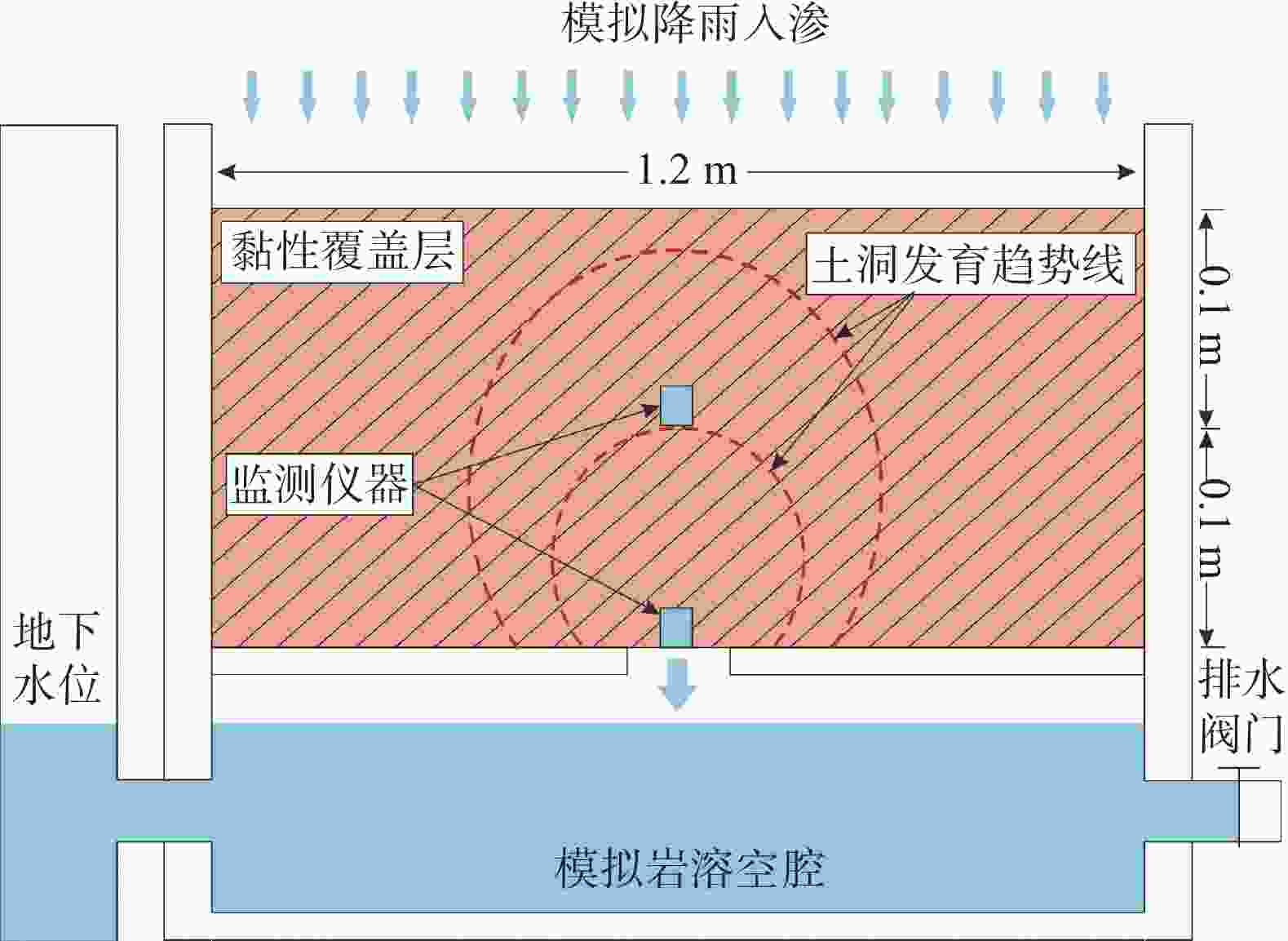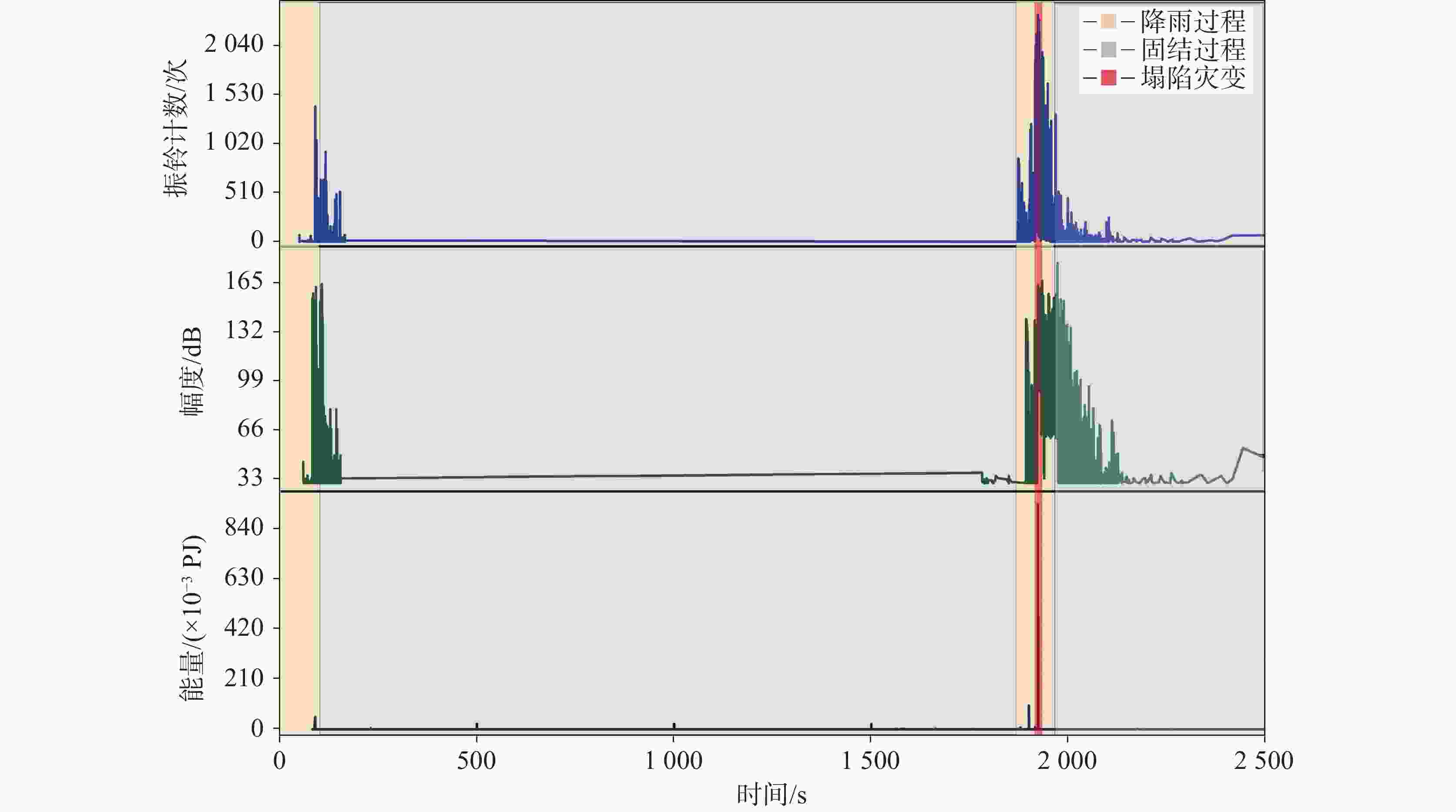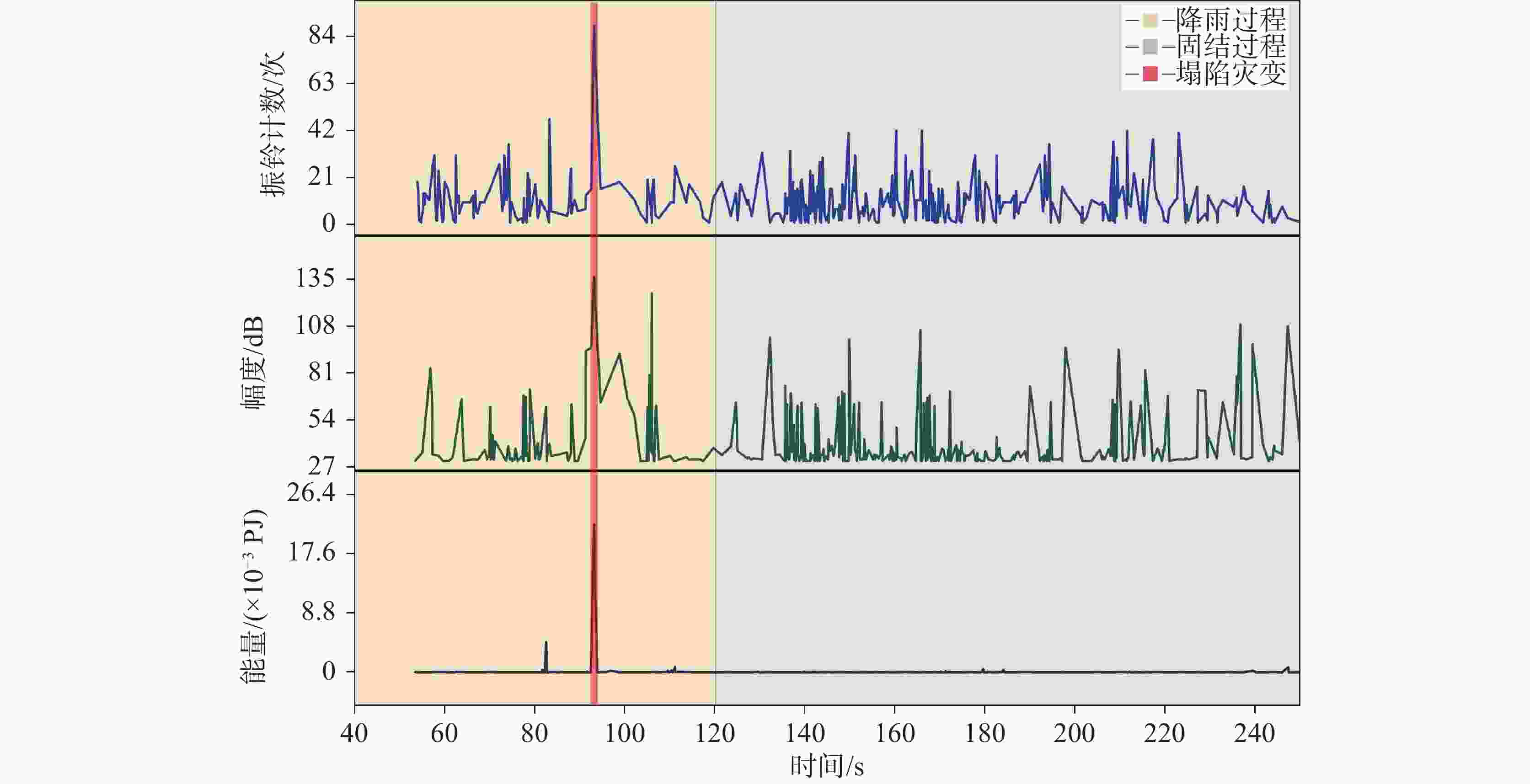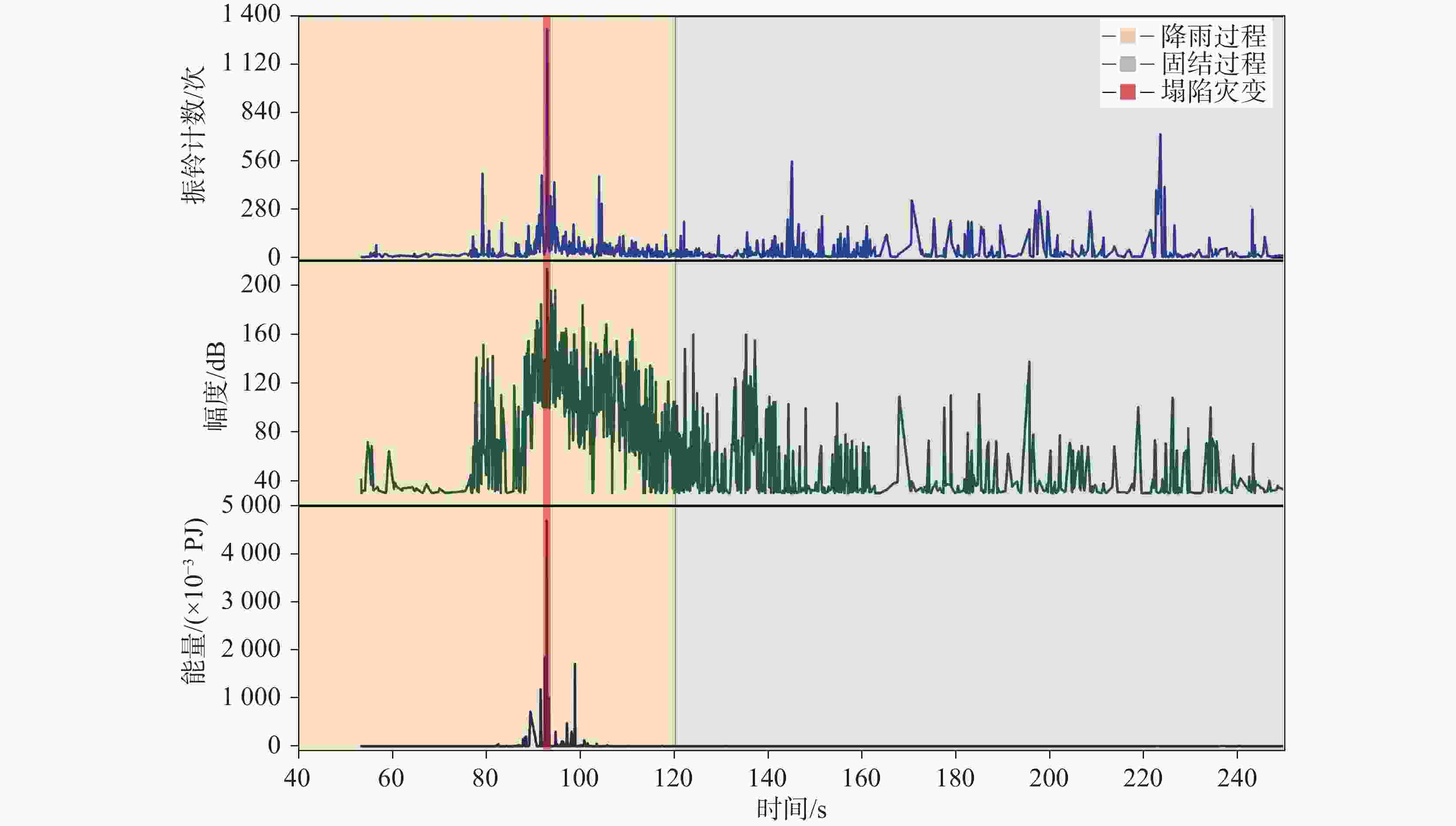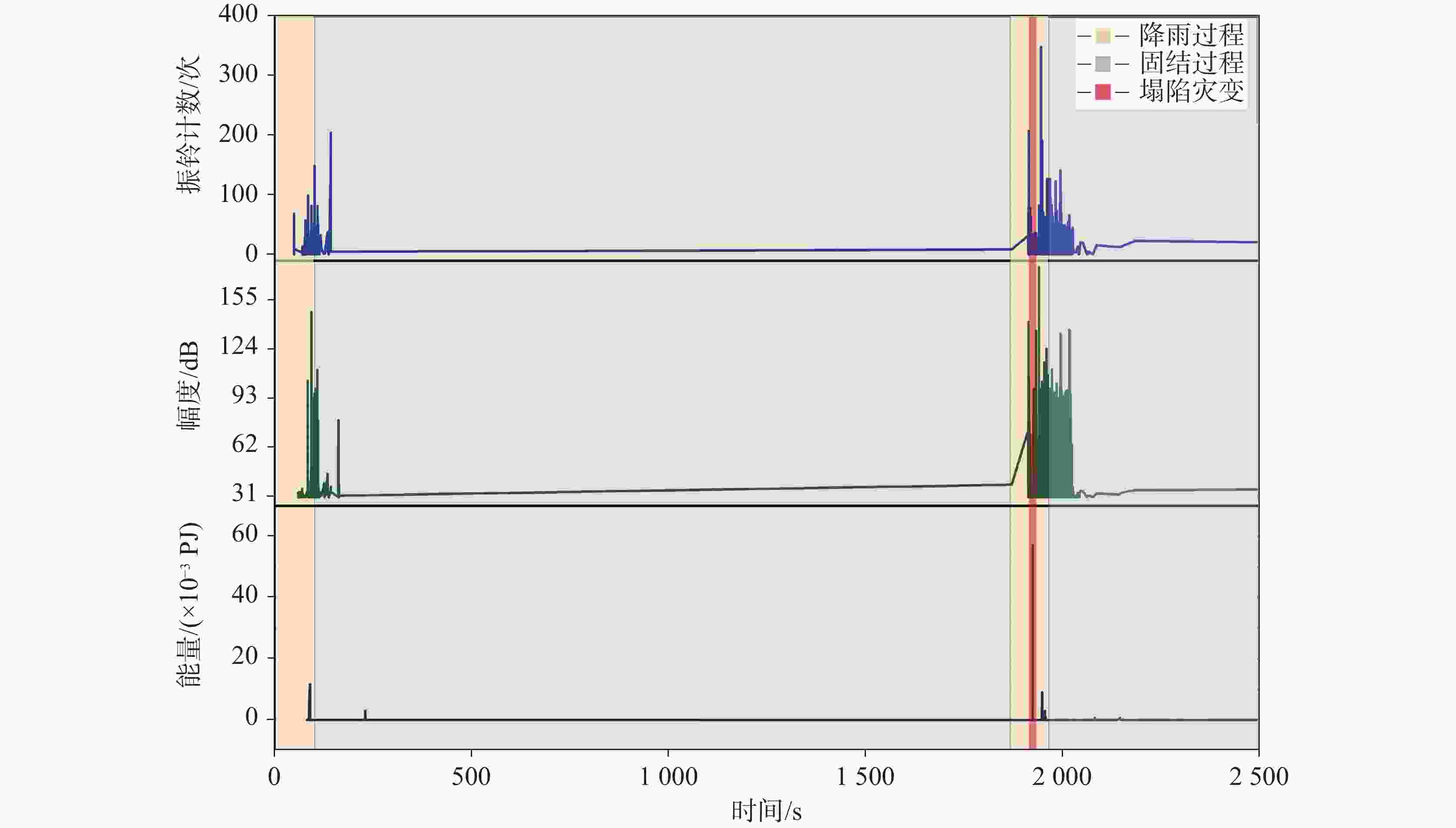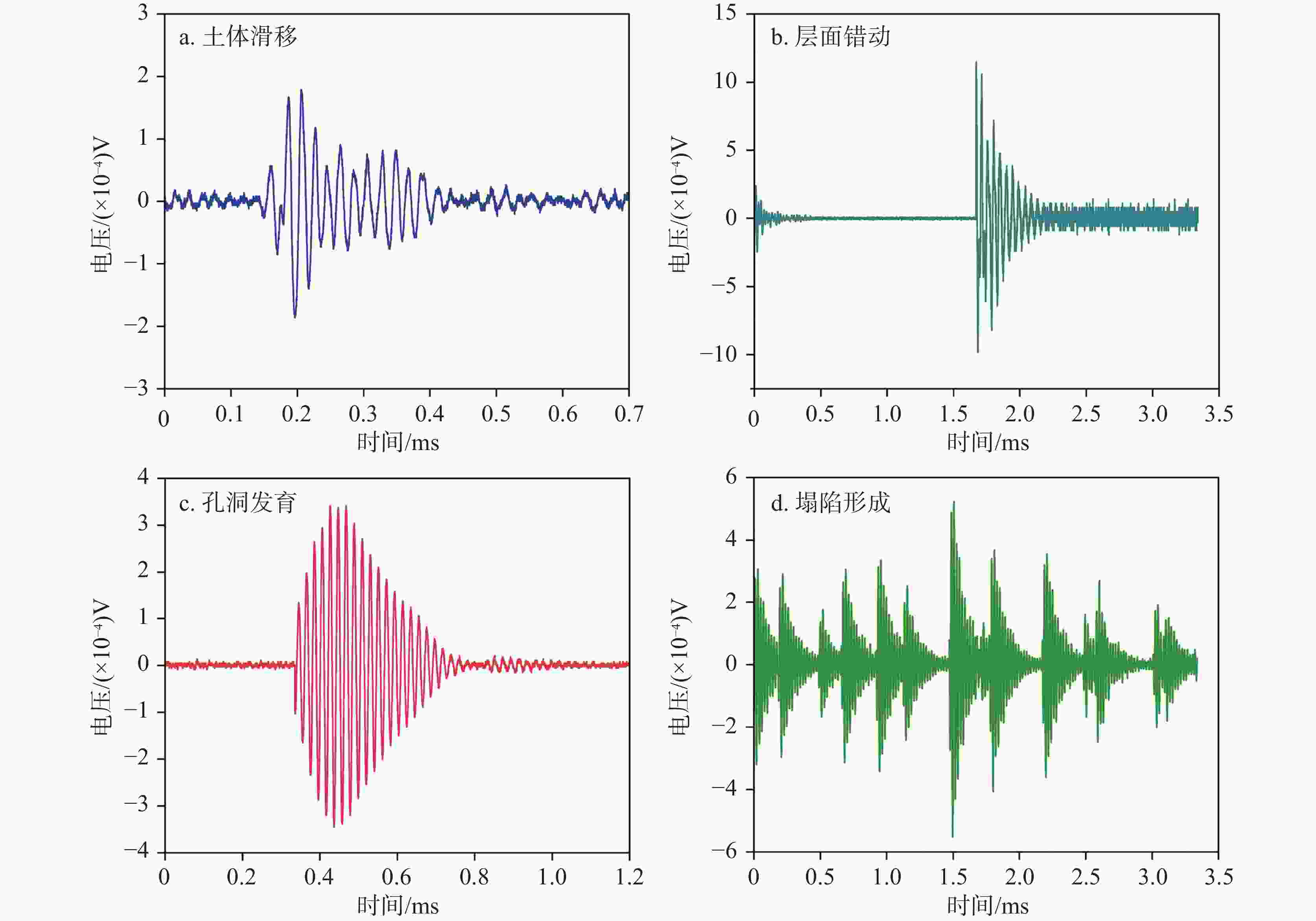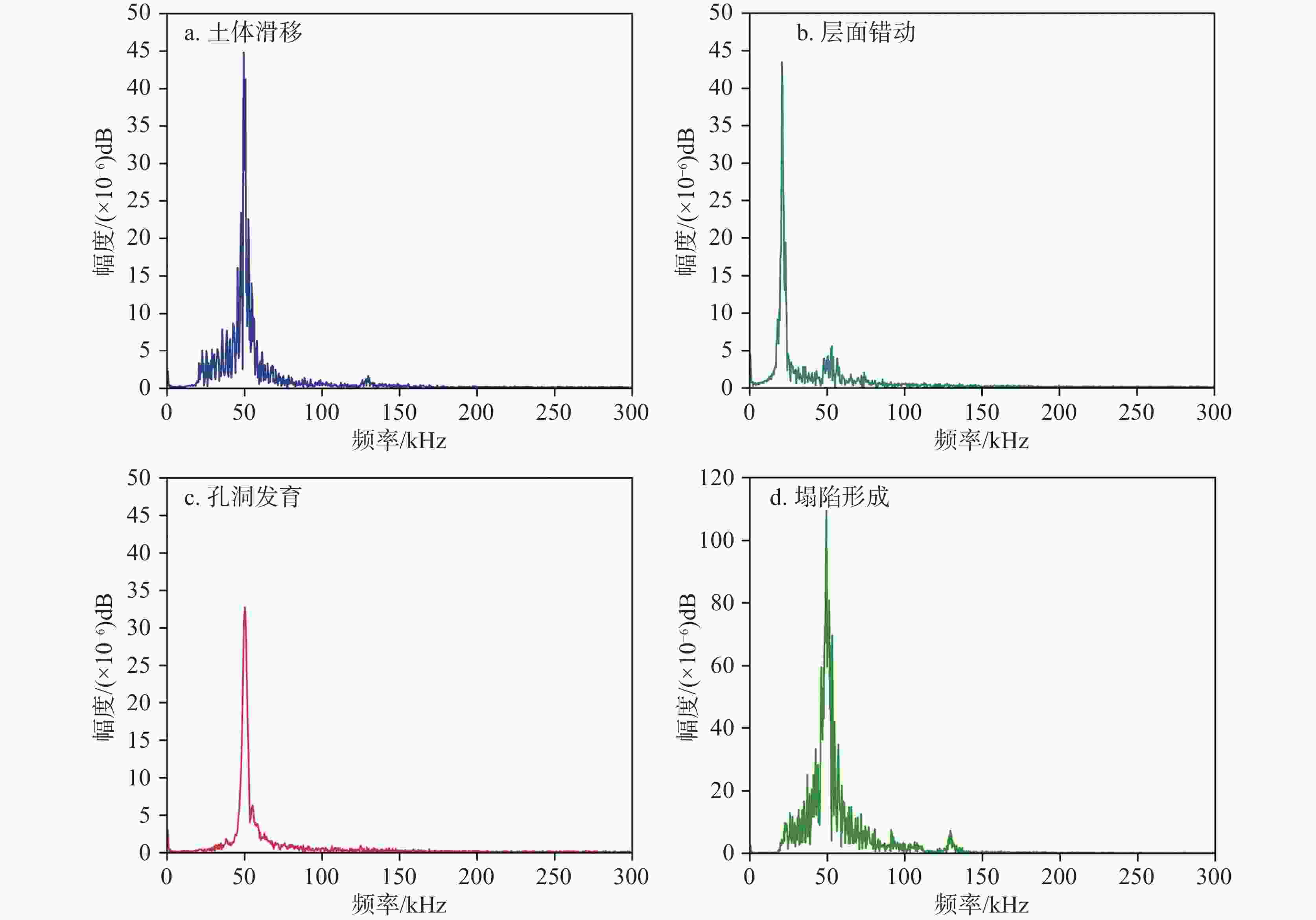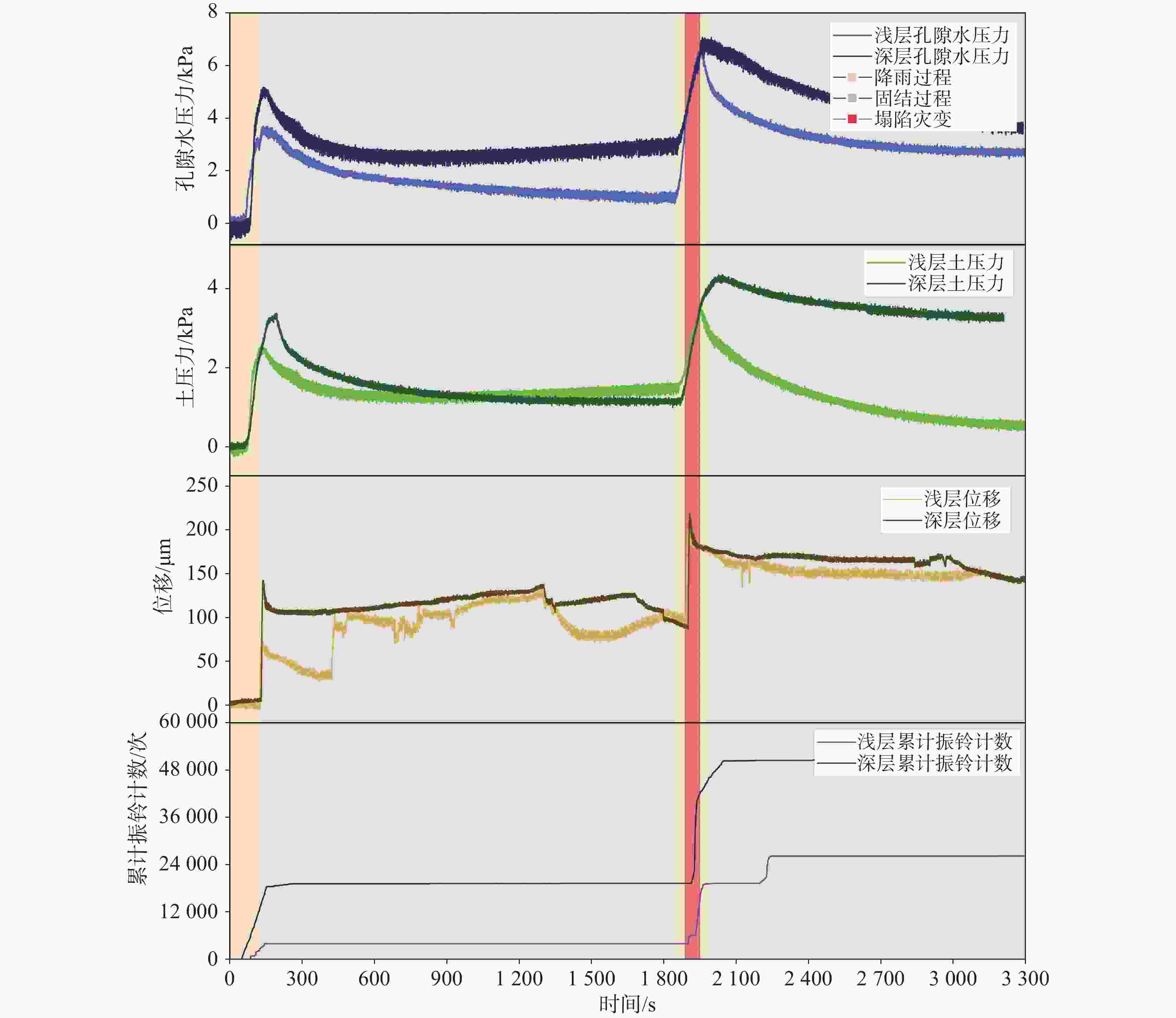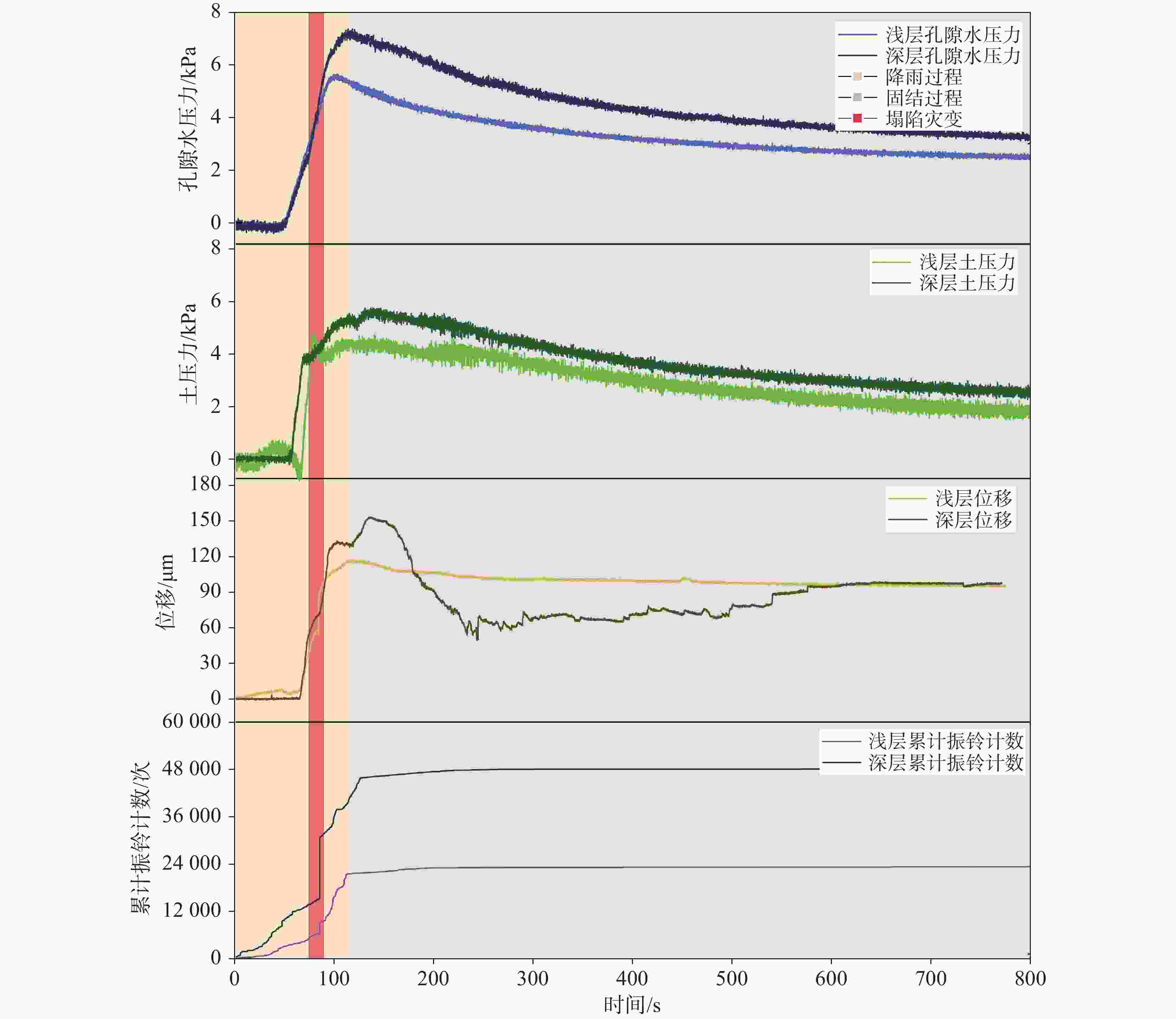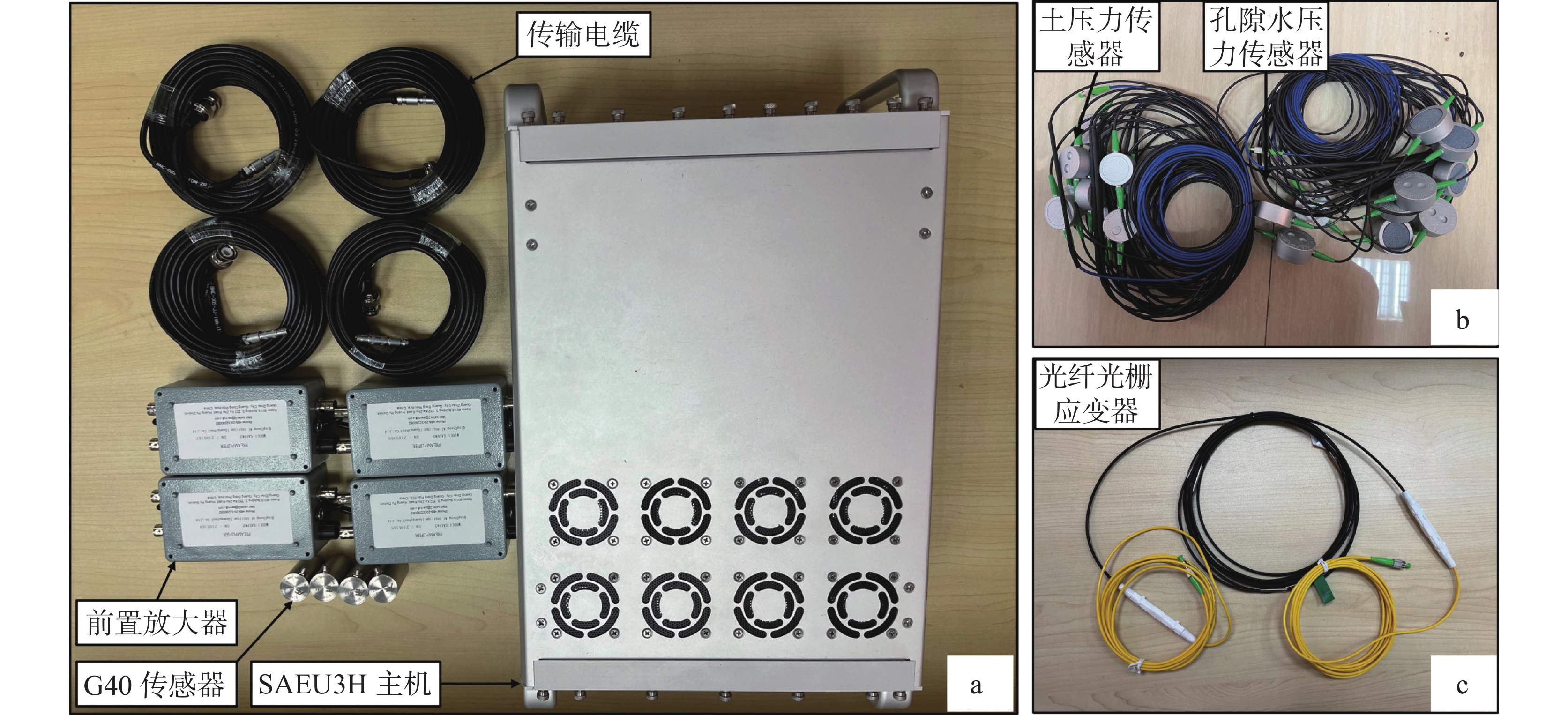Experiment on monitoring and early warning of karst collapses based on acoustic emission technology
-
摘要: 岩溶塌陷是土体损伤孔洞发育并最终导致盖层失稳的动力地质过程,故查明土体损伤特征及演化过程是提出有效监测预警方法的重要前提。文章利用声发射与光纤光栅传感技术对岩溶塌陷形成过程展开模型试验,甄别与筛选声发射关键信号特征,并建立其与岩溶塌陷的响应机制。试验结果表明:(1)大雨条件下岩溶塌陷的形成演化过程里,覆盖层深部声发射信号振铃计数较浅部增大6.78~6.89倍,幅度增大1.02~1.12倍,能量扩大了4.45~16.60倍。在暴雨条件下,覆盖层深部声发射信号振铃计数较浅部增大14.85倍,幅度增大1.51倍,能量扩大了213.39倍;(2)大雨试验工况下是以土洞扩展并失稳破坏的蠕变破坏型岩溶塌陷,暴雨试验工况下是土层整体错断坍塌的压剪断裂型岩溶塌陷,不同塌陷类型的声发射信号特征有明显差异;(3)岩溶塌陷过程中会出现土体滑移、层面错动、孔洞发育和塌陷四类信号波形,信号波形释能幅值、上升与下降时间、波形持续时间等与岩溶塌陷演化过程土体变形密切相关;(4)岩溶塌陷过程中声发射频谱信号波形为高频窄脉冲,其中土体滑移、层面错动、孔洞发育和塌陷等四类信号频域能量分别集中在50 kHz和20 kHz左右的高频区段;(5)声发射累计振铃计数与覆盖层孔隙水压力、土压力和土体位移的变化过程存在紧密的关联性,在土体变形与塌陷时会导致声发射振铃计数增加或突发性跃迁现象,因此证明声发射技术用于岩溶塌陷监测预警是可行的。Abstract:
The karst collapse is a dynamic geological process in which the damage of soil mass and development of cavity ultimately result in the instability of the overburden layer. Therefore, identifying the characteristics and evolution of the damage of soil mass are the important prerequisite to develop effective monitoring and early warning methods for karst collapses. However, the commonly used early warning methods that utilize hydrodynamic conditions and optical fiber monitoring technique often overlook both the process of microscopic damage of the soil mass and the effect of damage on karst collapses. Previous studies on karst collapses induced by groundwater or rainfall typically employ qualitative or semi-quantitative methods. These approaches appear to be one of the reasons why karst collapses—major and prevalent geological disasters in karst regions—have seen limited advancement in monitoring and early warning system. In this study, acoustic emission (AE) and fiber grating technology have been firstly applied to conduct model tests on monitoring and early warning methods of karst collapses. The research on dynamic characteristics of AE has been conducted under different rainfall conditions. In addition, the characteristics of key time domains and frequency domains of AE have been identified and selected to establish a spatial-temporal responding mechanism between AE and karst collapses through model experiment. The results show that as follows, (1) The total ringing count, amplitude, and energy of AE in the shallow overburden layer ranged from 1 times to 348 times, 30.5 dB to 175.9 dB, and 0 PJ to 57×10−3, respectively, under heavy rainfall conditions. In contrast, the same parameters in deep overburden layer ranged from 1 times to 2,361 times, 30.5 dB to 179 dB, and 0 PJ to 946.4×10−3 PJ, respectively. In addition, under rainstorm conditions, these parameters in shallow overburden layer ranged from 1 times to 89 times, 30.5 dB to 140.9 dB, and 0 PJ to 22×10−3 PJ, respectively, while in deep overburden layer, they ranged between 1 times and 1,322 times, 30.5 dB and 213.1 dB, 0 PJ and 4,694.6×10−3 PJ, respectively. During the formation of karst collapses under heavy rain conditions, the ringing count of AE in the deep overburden layer increased by 6.78 times to 6.89 times compared to the shallow layer. Additionally, the amplitude of AE in deep overburden layer increased by 1.02 times to 1.12 times compared to the shallow layer. The energy of AE in deep overburden layer increased by 4.45 times to 16.6 times compared to the shallow layer. During the formation of karst collapses under rainstorm conditions, the ringing count, amplitude and energy of acoustic emissions in deep overburden layer increased by 14.85 times, 1.51 times and 213.39 times, respectively, compared to the shallow layer. (2) Under heavy rain conditions, the karst collapses were defined as creep-failure collapses which were caused by the expansion and instability of soil caves. But the energy emitted by the final collapse of the soil cave was larger than the energy emitted by creep-failure collapse, which indicated higher activity of AE signals. Under rainstorm conditions, the karst collapse was defined as compression-shear fracture collapse caused by the whole fracture and collapse of soil mass. In this process, the strain energy in the soil layer was completely released in a short time. Hence, the AE signals showed a sharp increase in dynamic curve in the second rainfall. This result indicated a strong relationship between AE signal characteristics and types of collapse. (3) There are four types of signal waveforms in the formation of karst collapse, which can be divided as slippage of soil mass, dislocation of soil layer, development of cavity and layer collapse. The irregular up-down fluctuation of signals represented the slippage of soil mass, while concave triangle signals indicated that rainfall dislocated stability of soil layer. Additionally, wedge-shaped signals indicated that a tiny cave was developed in the overburden layer. The signals which were showed as combined form of equilateral triangle and concave triangle implied the occurrence of karst collapse. Therefore, the signal energy, rising and falling time and duration of signal waveforms were closely related to soil deformation in the process of karst collapse. (4) In the formation of karst collapse, the spectrum signal waveforms of AE fell into high frequency narrow pulse form, in which spectrum energy of the four signal types were concentrated in the high frequency range of about 50 kHz and 20 kHz, respectively. (5) The cumulative ringing counts of AE were closely related to pore water pressure, soil pressure and displacement of soil mass. The ringing counts of AE increased in sudden during soil deformation or collapse. This observation indicated that AE technology is feasible for monitoring and early warning of karst collapses. -
表 1 试验材料基本物理力学指标
Table 1. Basic physical and mechanical indexes of the experimental materials
最优含水率
$ \omega $/%最大干密度
${\rho }_{d}/g\cdot {cm}^{-1}$液限
$ {W}_{L} $/%塑限
$ {W}_{p} $/%塑性指数
$ {I}_{p} $土粒比重
$ {G}_{s} $压缩模量
$ {E}_{s} $/Mpa30.21 1.46 51.24 34.34 19.9 2.725 10.11 -
[1] 康彦仁. 岩溶塌陷的形成机制[J]. 广西地质, 1989, 2(2):83-90.KANG Yanren. On the mechanism of karst collapses[J]. Geology of Guangxi, 1989, 2(2):83-90. [2] 雷明堂, 蒋小珍. 岩溶塌陷研究现状、发展趋势及其支撑技术方法[J]. 中国地质灾害与防治学报, 1998, 9(3):1-6.LEI Mingtang, JIANG Xiaozhen. Research on the present situation and developing tendency of karst collapse and techniques for its supporting[J]. The Chinese Journal of Geological Hazard and Control, 1998, 9(3): 1-6. [3] 廖如松. 应用逐步判别法预测岩溶塌陷探讨:以桂林岩溶地区为例[J]. 中国岩溶, 1987, 6(1):79-91.LIAO Rusong. Application of stepwise discriminant analysis to predict land collapse: A case of Guilin karst region[J]. Carsologica Sinica, 1987, 6(1): 79-91. [4] 项式均, 陈健, 覃有强. 湖北大冶县大广山铁矿岩溶塌陷的预测和评价[J]. 中国岩溶, 1987, 6(4):297-314.XIANG Shijun, CHEN Jian, QIN Youqiang. Prediction and evaluation of karst collapse in Daguangshan iron mine in Daye county, Hubei[J]. Carsologica Sinica, 1987, 6(4): 297-314. [5] 武鑫, 黄敬军, 缪世贤. 基于层次分析-模糊综合评价法的徐州市岩溶塌陷易发性评价[J]. 中国岩溶, 2017, 36(6):836-841. doi: 10.11932/karst20170606WU Xin, HUANG Jingjun, MIAO Shixian. Susceptibility zoning and mapping of karst collapse in Xuzhou using analytic hierarchy process-fuzzy comprehensive evaluation method[J]. Carsologica Sinica, 2017, 36(6): 836-841. doi: 10.11932/karst20170606 [6] 蒙彦, 殷坤龙, 雷明堂. 水位波动诱发岩溶塌陷的概率分析[J]. 中国岩溶, 2006, 25(3):239-243. doi: 10.3969/j.issn.1001-4810.2006.03.009MENG Yan, YIN Kunlong, LEI Mingtang. Probabilistic analysis on karst collapse induced by water table fluctuation[J]. Carsologica Sinica, 2006, 25(3): 239-243. doi: 10.3969/j.issn.1001-4810.2006.03.009 [7] 高宗军, 鲁统民, 王敏, 冯建国, 刘书江, 王姝. 基于岩溶水动态的岩溶地面塌陷预测预报方法[J]. 中国岩溶, 2019, 38(5):739-745. doi: 10.11932/karst2019y09GAO Zongjun, LU Tongmin, WANG Min, FENG Jianguo, LIU Shujiang, WANG Shu. Prediction of karst ground collapse based on karst water regime[J]. Carsologica Sinica, 2019, 38(5): 739-745. doi: 10.11932/karst2019y09 [8] 管振德, 蒋小珍, 高明. 岩溶塌陷光纤传感试验装置的标定试验[J]. 中国岩溶, 2012, 31(2):173-179. doi: 10.3969/j.issn.1001-4810.2012.02.010GUAN Zhende, JIANG Xiaozhen, GAO Ming. A calibration test on optical fiber sensing device for karst collapse monitoring[J]. Carsologica Sinica, 2012, 31(2): 173-179. doi: 10.3969/j.issn.1001-4810.2012.02.010 [9] Jiang X Z, Gao Y L, Wu Y B, Lei M T. Use of brillouin optical time domain reflectometry to monitor soil-cave and sinkhole formation[J]. Environmental Earth Sciences, 2016, 75(3): 225. doi: 10.1007/s12665-015-5084-1 [10] 蒋小珍, 雷明堂, 管振德. 湖南宁乡大成桥充水矿山疏干区岩溶系统水气压力监测及突变特征[J]. 中国岩溶, 2016, 35(2):179-189. doi: 10.11932/karst20160207JIANG Xiaozhen, LEI Mingtang, GUAN Zhende. Character of water or barometric pressure jump within karst conduit in large strong drainage area of karst water filling mine in Dachengqiao, Ningxiang, Hunan[J]. Carsologica Sinica, 2016, 35(2): 179-189. doi: 10.11932/karst20160207 [11] 姜伏伟, 张发旺, 柳林, 刘伟, 李亮, 陈航. 南宁地铁施工降水诱发岩溶塌陷条件及安全防控措施[J]. 中国岩溶, 2018, 37(3):415-420. doi: 10.11932/karst20180312JIANG Fuwei, ZHANG Fawang, LIU Lin, LIU Wei, LI Liang, CHEN Hang. Dewatering induced karst collapse conditions and safety prevention and control measures in Nanning subway construction[J]. Carsologica Sinica, 2018, 37(3): 415-420. doi: 10.11932/karst20180312 [12] 王滨, 李治广, 董昕, 陈立. 岩溶塌陷的致塌力学模型研究:以泰安市东羊娄岩溶塌陷为例[J]. 自然灾害学报, 2011, 20(4):119-125.WANG Bin, LI Zhiguang, DONG Xin, CHEN Li. Study on mechanical model of karst collapse: A case of karst collapse in Dongyanglou village, Tai'an City[J]. Journal of Natural Disasters, 2011, 20(4): 119-125. [13] 高培德, 王林峰. 覆盖型岩溶塌陷的塌陷机制分析[J]. 中国岩溶, 2017, 36(6):770-776. doi: 10.11932/karst20170602GAO Peide, WANG Linfeng. Analysis of collapse mechanism for mantled karst collapse[J]. Carsologica Sinica, 2017, 36(6): 770-776. doi: 10.11932/karst20170602 [14] Nair A, Cai C S. Acoustic emission monitoring of bridges: Review and case studies[J]. Engineering Structures, 2010, 32(6): 1704-1714. doi: 10.1016/j.engstruct.2010.02.020 [15] Fricker S, Vogel T. Site installation and testing of a continuous acoustic monitoring[J]. Construction and Building Materials, 2007, 21(3): 501-510. doi: 10.1016/j.conbuildmat.2006.04.008 [16] Dixon N, Spriggs M P, Smith A, Meldrum P, Haslam E. Quantification of reactivated landslide behaviour using acoustic emission monitoring[J]. Landslides, 2015, 12(3): 549-560. [17] Cheon D S, Jung Y B, Park E S, Song W K, Jang H I. Evaluation of damage level for rock slopes using acoustic emission technique with waveguides[J]. Engineering Geology, 2011, 121(1): 75-88. [18] Koerner R M, Lord A E. Acoustic emissions in stressed soil samples[J]. The Journal of the Acoustical Society of America, 1974, 56(6): 1924-1927. doi: 10.1121/1.1903538 [19] Kurlenya M V, Petrov V E, Popov S N, Tkach K B. Applicability of acoustic waveguides for stress measurement in soils[J]. Journal of Mining Science, 1997, 33(1): 88-93. doi: 10.1007/BF02765435 [20] Huang M H, Lauchle G C, Wang M C. Seepage-induced acoustic emission in granular soils[J]. Journal of Geotechnical and Geoenvironmental Engineering, 2009, 135(4): 566-572. doi: 10.1061/(ASCE)1090-0241(2009)135:4(566) [21] Leary D, Dicarlo D A, Hickey C J. Acoustic techniques for studying soil-surface seals and crusts[J]. Ecohydrology, 2009, 2(3): 257-262. [22] Lu Z Q, Wilson G V. Acoustic measurements of soil pipeflow and internal erosion[J]. Soil Science Society of America Journal, 2011, 76(3): 853-866. [23] 陈天奇. 复合岩土声发射试验研究[D]. 武汉:华中科技大学, 2014.CHEN Tianqi. Experiment of acoustic emission of composites from rock and soil[D]. Wuhan: Huazhong University of Science and Technology, 2014. [24] Mao W W, Shogo A, Shigeru G. Acoustic emission characteristics of subsoil subjected to vertical pile loading in sand[J]. Journal of Applied Geophysics, 2015, 119: 119-127. [25] 闫梦晴, 李明宝, 于司杭, 郑宪. 土无侧限抗压试验中的声发射特性研究[J]. 科学技术与工程, 2015, 15(33):142-146. doi: 10.3969/j.issn.1671-1815.2015.33.024YAN Mengqing, LI Mingbao, YU Sihang, ZHENG Xian. Acoustic emission characteristic in soil unconfined compression test[J]. Science Technology and Engineering, 2015, 15(33): 142-146. doi: 10.3969/j.issn.1671-1815.2015.33.024 [26] 李明宝, 孙振国, 陈冲, 郑宪, 闫梦晴, 于司杭. 单轴压缩下土体声发射参数与力学参数关系研究[J]. 科学技术与工程, 2016, 16(30):278-284. doi: 10.3969/j.issn.1671-1815.2016.30.049LI Mingbao, SUN Zhenguo, CHEN Chong, ZHENG Xian, YAN Mengqing, YU Sihang. Study the relationship between acoustic emission parameters and mechanical parameters in soil unconfined compression test[J]. Science Technology and Engineering, 2016, 16(30): 278-284. doi: 10.3969/j.issn.1671-1815.2016.30.049 [27] 张攀. 松散堰塞坝溃决的声发射响应试验研究[D]. 成都:成都理工大学, 2017.ZHANG Pan. Experimental study on acoustic emission response of loose dam failure[D]. Chengdu: Chengdu University of Technology, 2017. -




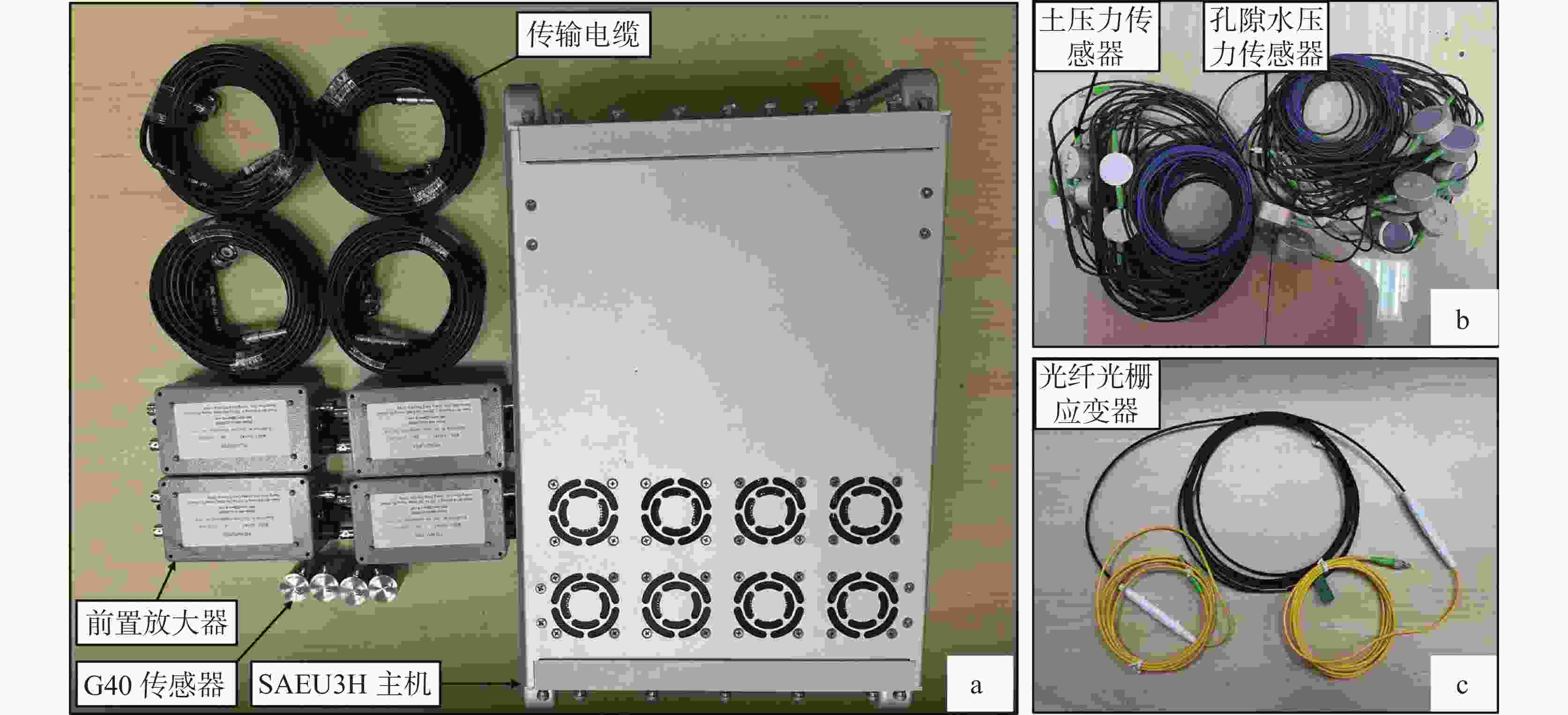
 下载:
下载:
